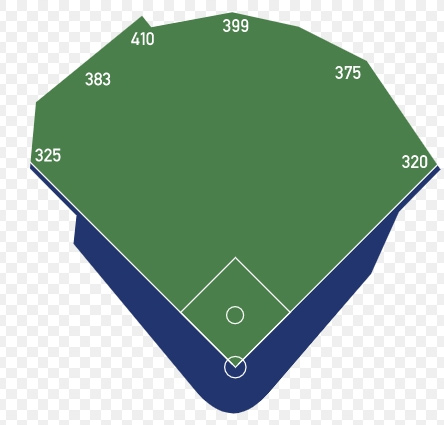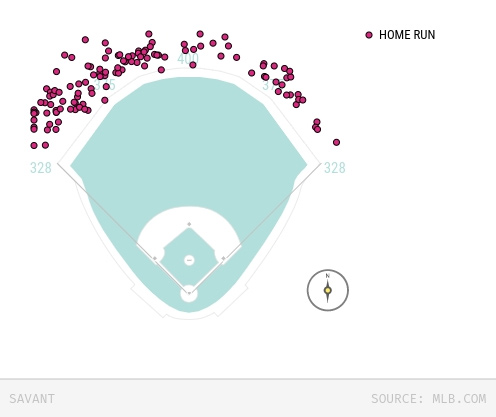Just two days from the start of the regular season, the Toronto Blue Jays appear to have finally found a temporary home.
Now the club is expected to share PNC Park for 2020, a development that punctuates just how bizarre this season will be. While the Pittsburgh Pirates’ ballpark is gorgeous and consistently ranks as one of the best baseball venues in existence, it is tough to spin not being able to play in your team’s intended city – or even country – as a positive.
Livestream Toronto Blue Jays games all season with Sportsnet NOW. Plus, watch marquee MLB matchups, the post-season and World Series.
At this point, it’s hard to speculate on how setting up camp in Pittsburgh will affect the Blue Jays’ morale or if a lack of home-field advantage means anything in a fan-less season. What we can do is take a look at PNC Park and try to project how its attributes might affect the team from a competitive standpoint.
That process starts by taking a peek at its dimensions, which are fairly similar to Rogers Centre.
| Park | Left Field | Left-Centre | Centre | Right-Centre | Right Field |
|---|---|---|---|---|---|
| PNC Park | 325 | 383 | 399 | 375 | 320 |
| Rogers Centre | 328 | 375 | 400 | 375 | 328 |
| Difference | -3 | 8 | -1 | 0 | -8 |
These numbers don’t tell the whole story, especially when comparing these two ballparks. Rogers Centre is often a climate-controlled environment while PNC is open to the elements. To get a sense of how the two “play” you need to look at park factors. The chart below shows how each encourages runs, hits, double, triples and home runs on average over the last five years, according to ESPN’s park factors. With these numbers, a score of 1 reflects total neutrality while anything higher favours hitters and anything lower favours pitchers.
| Statistic | Rogers Centre | PNC Park |
|---|---|---|
| Runs | 0.99 | 0.95 |
| Hits | 0.99 | 1 |
| Doubles | 1.09 | 1.07 |
| Triples | 0.96 | 0.98 |
| Home Runs | 1.08 | 0.9 |
In an overall sense, these ballparks play similarly, but there is a massive difference between them when it comes to home runs. Rogers Centre is a great place to hit long balls and PNC Park is a tough spot to get your trot on. That fact alone is not ideal for the Blue Jays, who have more than their share of dinger-reliant bats in their order.
However, it’s not quite as simple as that because PNC Park is not egalitarian in its home run theft. Instead, it preys exclusively on right-handed hitters. The basic dimensions above are a bit deceiving because the venue features a mammoth kink just to the right of the traditional left-centre measurement.
That feature is going to be trouble for the Blue Jays’ right-handed power hitters. According to FanGraphs’ Park Factors, in the 17 seasons between 2002 and 2018 PNC Park rated as one of the top-three worst spots for right-handers to go deep 14 times.
When it comes to the Blue Jays and right-handed power, there are five names that come to mind: Vladimir Guerrero Jr., Bo Bichette, Randal Grichuk, Teoscar Hernandez and Lourdes Gurriel Jr. Each could find their new home an unforgiving place, but it won’t affect them all equally.
Predicting PNC Park’s primary victim depends on a couple of factors. The first is who hits the most flyballs. Line drives tend to go for hits regardless of the ballpark, and while it’s possible that a couple of possible home runs hit the wall for a double instead, the bigger problem is opposing outfielders settling under balls that would have been in the seats elsewhere. The second thing to figure out is who’s most likely to hit the balls that way. In order to achieve that, we’ll look at who hits the ball to left or centre most often when they do hit flies. The combination of volume and directionality will give us an idea of who’s most at risk.
| Player | Career Flyball Rate | Flyballs Pulled or hit to Centre |
|---|---|---|
| Vladimir Guerrero Jr. | 33.10% | 63.70% |
| Bo Bichette | 33.60% | 51.00% |
| Lourdes Gurriel Jr. | 38.50% | 59.90% |
| Teoscar Hernandez | 43.50% | 61.40% |
| Randal Grichuk | 43.50% | 65.60% |
Guerrero Jr. and Bichette’s numbers come from a small enough sample that it’s hard to make a definitive call on them. The latter does seem relatively safe because of his all-fields approach and the former needs to worry about elevating the ball more before something like this becomes a concern.
With the more veteran hitters, Grichuk seems likely to suffer the most, and a look at his career home run spray chart shows a few balls that PNC might eat up – although to his credit, he’s not one for fence scrapers.
The pitching side of this equation comes down to imagining which Blue Jays pitchers would benefit most from the nullification of right-handed power. Southpaw starters like Hyun-Jin Ryu and Ryan Borucki get a boost because opposing managers are likely to stack lineups with right-handers against them. Although both have healthy groundball rates, suppressing home runs is a big part of each of their games and PNC Park can only help with that.
Another pitcher who could see his new home improve his fortunes is Trent Thornton. Last season, Thornton’s groundball rate of 32.9 per cent was the third-lowest in the majors among starters with at least 150 innings pitched. If opponents are consistently getting the ball in the air against him, it could pay for the sophomore to play in a power-sapping park. Although the sample will be awfully small, low groundball rate guys in the bullpen like Ken Giles (39.3 per cent) and Wilmer Font (36.8 per cent) could also reap the benefits.
Considering we’re talking about less than half of a 60-game season, the result of all of this may be literally a couple of plays. However, in this mad sprint two or three plays could make a huge difference – especially to a club like the Blue Jays, whose playoff chances rest on the edge of a knife.
https://news.google.com/__i/rss/rd/articles/CBMiXmh0dHBzOi8vd3d3LnNwb3J0c25ldC5jYS9iYXNlYmFsbC9tbGIvYmx1ZS1qYXlzLXBsYXllcnMtd2lsbC1pbXBhY3RlZC10ZW1wb3JhcnktcG5jLXBhcmstbW92ZS_SAQA?oc=5
2020-07-22 17:24:00Z
52780940652575



Tidak ada komentar:
Posting Komentar